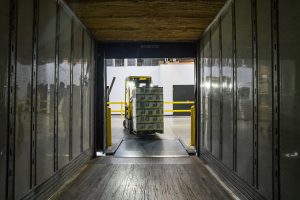Logistics Firms Reducing Employees: A New Trend in the Face of Economic Uncertainty
Economic uncertainty forces layoffs

Freight forwarder Flexport laid off 20 percent of its workforce last month, citing a macroeconomic downturn that is hurting its customers.
Recent layoffs at big-name logistics companies could be the start of a wider culling of supply chain jobs amid economic uncertainty, according to experts, leaving plenty of talent available for firms still hiring. Freight forwarder Flexport laid off 20 percent of its workforce last month, citing a macroeconomic downturn that is hurting its customers. Other seasoned industry names, including C.H. Robinson and DSV, are also relying on layoffs or hiring freezes as a way to reduce their labor costs.
Adjusting organizational structures
“Lower volumes, combined with improved efficiencies as a result of new organizational and operational structures, means we are overstaffed in a variety of roles across the company,” Dave Clark and Ryan Petersen, chief executives, told employees in a Jan. 11 memo. Many companies in the sector had aggressively expanded their employee ranks to keep up with heightened demand sparked by the COVID-19 pandemic. Oftentimes, they competed in pricey bidding wars for talent across the supply chain.
The impact of cooling consumer spending

But with consumer spending now cooling in a cloudy economic environment, accelerated growth has turned into bloated operating expenditures over the past several months.
But with consumer spending now cooling in a cloudy economic environment, accelerated growth has turned into bloated operating expenditures over the past several months. As vulnerable companies respond by slashing payrolls, they leave an opening for other businesses to swoop in and add seasoned talent to their ranks.
Enjoying our insights?
Subscribe to our newsletter to keep up with the latest industry trends and developments.
Stay InformedTechnology companies under pressure
Companies offering technology-driven logistics services and platforms are at the highest risk to enact future layoffs, said Spencer Shute, principal consultant at Proxima. Shippers aren’t often looking to implement pricey new technology during an economic downturn, limiting the growth of the likes of Flexport, he added.
Cutting labor costs
Many logistics firms have the option to pare down their network’s transportation and warehousing assets, such as FedEx cutting back its flight frequencies. But companies with few—if any—physical assets to begin with don’t have that as an option. “They don’t have the assets or the fleets or maintenance programs, things like that, that they can try to reduce costs on,” Shute said. “It ultimately comes down to labor, which is their biggest expense.”
Targeting specific roles
Recruiting and sales employees are often targets of labor cost-cutting measures, and engineering roles could be at risk at some logistics companies, Shute said. On the other hand, more manual positions such as drivers and warehouse staff continue to be a high hiring priority for many employers.
Warehousing employment decline

Seasonally adjusted warehousing and storage employment fell about 3.7 percent from June to December, according to the U.S. Bureau of Labor Statistics.
But even front-line jobs haven’t been immune to wider economic pressures. Seasonally adjusted warehousing and storage employment fell about 3.7 percent from June to December, according to the U.S. Bureau of Labor Statistics.
Unique challenges in the current environment
Reducing labor costs in response to weakening demand isn’t a new scenario for the logistics sector. However, the current environment has some unique qualities compared to past downturns that could give companies added pause before enacting their own cost-cutting measures, said Brad Hulbert, a director in Grant Thornton’s sourcing and supply chain practice.
Balancing labor force and expenses
Employers are attempting to rightsize their labor force while at the same time trying to minimize losses from recent hires, who have often required elevated recruiting and training expenses in a competitive hiring environment. Hulbert added that many companies are already doing more logistics work with fewer employees, often by relying on technology platforms to reduce the amount of people needed to track shipments.
The difficulty of reducing operating expenses
“It gets harder and harder to squeeze that operating expenditure out of your annual levels, because you have already reduced headcount over the last five to 10 years with those efficiency gains in technology,” Hulbert said.
Resilient competitors stand to benefit

Chris Shields, global chief executive and founder of freight and logistics recruitment firm Freightalent, said there are plenty of candidates in the freight technology space available for hire, such as designers, developers, and engineers.
With several logistics firms reducing employees and pressing pause on hiring, an influx of talent is now looking for work. Chris Shields, global chief executive and founder of freight and logistics recruitment firm Freightalent, said there are plenty of candidates in the freight technology space available for hire, such as designers, developers, and engineers. Resilient competitors with consistent growth have taken advantage of the situation, swooping in and bolstering their ranks with experienced employees.
Hiring continues in specific areas
Even the firms that have announced layoffs continue to hire in other areas. C.H. Robinson has jobs in operations, technology, and other areas open. Flexport, meanwhile, is looking to double its software engineering talent as it waits for conditions to improve.
Flexport’s long-term strategy
“The current slowdown in volume gives us time to focus on building our technology bench while the economy lags,” Flexport’s memo said. “Then, as the economy recovers, we will be ready to be the Flexport that we all want to be–the one stop for customers to make the movement of goods around the world easy.”
The consequences of large-scale layoffs
However, Shields said employers with sudden, large-scale layoff announcements could be a deterrent to their recruiting efforts, even when customers’ volumes rebound and hiring ramps up again. “It’s going to be a massive advantage for all these other companies who are going through steady and solid growth continually,” Shields said. “They’re going to be able to get good talent, just because these other companies kind of shot themselves in the foot a little bit in the way that they’ve managed things.”
In conclusion, logistics firms reducing employees in response to economic uncertainty is not a new phenomenon, but the current environment presents unique challenges for companies. While some businesses are cutting labor costs, others are taking advantage of the situation to hire experienced talent. Resilient competitors stand to benefit from this trend, while companies enacting large-scale layoffs may face recruiting difficulties in the future. As the industry continues to navigate these uncertain times, it remains to be seen how these changes will shape the logistics sector in the long term.
For more news on Logistics in the Transportation Industry click here.
External resources:


















